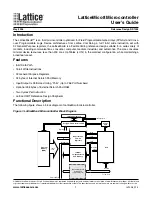
Battery Connections
The RRC²X is designed to be operated with a standard 9-volt alkaline battery. Always purchase and use premium alkaline
batteries; 9-volt Nicad batteries may also be used -- however, the voltage of this battery type can range from 7.2 to 8.4 volts.
A higher voltage Nicad is more desirable, as 7.2 volts is on the very edge of operational acceptance. When your battery
voltage is too low, the continuity circuit will fail to operate and will not report (beep) the status of the ejection charges. This
is a good indication that it's time to change your battery. It can reliably operate using battery systems up to 12 volts.
IMPORTANT: Always load test your battery prior to flight to ensure adequate power for reliable operation and
ignition of the ejection charges. Inadequate sizing of an external battery system will damage or cause the unit to
malfunction. Always pre-test your external battery system design prior to launch.
To load test a 9V battery, you will require a DC multimeter capable of DC amp measurement with a 10 amp capability. A 9-
volt battery can easily source in excess of 5 amps. Briefly connect the meter leads across the battery terminals to measure
the DC current capacity. If the measurement is close to or drops below 2 amps, do not use the battery. Some batteries
have built in testers, however it is still recommended that a meter be used for testing. Nominal load during operation is about
Mounting Considerations
The payload section or electronics bay used for the RRC²X must be a sealed chamber with a static pressure equalization
port. The sealing of the chamber is necessary for several reasons:
Isolation of the electronics from the ejection-charge heat, residue, and over-pressure
Isolation from the aerodynamic pressure and vacuum effects on the rocket airframe during flight
Provides uniform static pressure equalization to ambient flight conditions
IMPORTANT: Inadequate sealing of the payload section or electronics bay, or exposure of the electronics to ejec-
tion-charge heat, residue, or pressure will cause the RRC²X to malfunction.
Static Pressure Ports
Equally as important as sealing the electronics bay or payload section is the proper location, sizing, quality, and quantity of
static pressure ports. Always try to locate a static port on the airframe where it is not obstructed by any object that may
cause turbulence upstream of the airflow over the port. Also try to locate the static port as far away as possible from the
nose cone or body transition sections. The rule of thumb is a ¼” diameter hole for every 100 cubic inches of bay volume.
Bay Volume Calculations
The first step to sizing of the static port hole is to compute volume… use the following formula:
Volume (cubic inches) = Bay Radius (inches) x Bay Radius (inches) x Bay Length (inches) x 3.14
With the known volume of the electronics bay or payload section, calculate the required nominal diameter for a single static
port with the appropriate formula:
If volume <= 100 cubic inches, you can use this simple approximation for a vent hole:
Single Port Diameter (inches) = Volume / 400
If volume > 100 cubic inches, use this formula to calculate vent hole diameter(s):
Single Vent Diameter = 2 * SQRT ( Volume * 0.0004908 / 3.14 )
Single Vent Area = ( Single Vent Diameter / 2 ) * ( Single Vent Diameter / 2 ) * 3.14
Multi Vent Diameter = 2 * SQRT ( ( Single Vent Area / # of holes ) / 3.14 )
Product Warranty
Missile Works Corporation has exercised reasonable care in the design and manufacture of this product and warrants the
original purchaser that the RRC²X Rocket Recovery Controller is free of defects and that will operate at a satisfactory level
of performance for a period of one year from the original date of purchase. If the system fails to operate as specified, then
return the unit (or units) within the warranty period for repair or replacement (at our discretion). The system must be re-
turned by the original purchaser, and be free of modification or any other physical damage which renders the system inop-
erable. Upon repair of replacement of the unit, Missile Works Corporation will return the unit postage paid, to the original
purchaser.
Product Disclaimer and Limit of Liability
Because the use and application of this equipment are beyond our control, the purchaser or user agrees to hold harmless
Missile Works Corporation and their agents from any and all claims, demands, actions, debts, liabilities, judgements, costs,
and attorney fees arising out of, claimed on account of, or in any manner predicated upon loss or damage to property of, or
injuries to or the death of any and all persons arising out of the use this equipment. Due to the nature of electronic devices,
the application and environments for those devices, the possibility of failure can never be totally ruled out. It is the responsi-
bility of the purchaser or user of this equipment to properly test and simulate the actual conditions under which the device is
intended to be used to ensure the highest degree of reliability and success.
Missile Works Corporation
Tel: 303.823.9222 / Fax: 303.823.9777
PO Box 1725
On the World Wide Web @
www.missileworks.com
Lyons, CO. 80540
Copyright 2000-2006 by Missile Works Corporation.
All
rights
reserved.
User Manual and Instructions
Model RRC²X 25K/40K versions
Revision C
System Overview
The RRC
2
X Rocket Recovery Controller provides two stage barometrically controlled deployment of rocket recov-
ery systems and equipment. Two-stage (or dual) deployment is preferable to single parachute or streamer recov-
ery systems for high-power rocketry. Recovery of large, heavy rockets with a small parachute or streamer alone
does not supply enough drag to safely recover the rocket without damage. An adequately sized parachute de-
ployed at a high altitude may cause the rocket to drift out of the launch area, making recovery difficult if not impos-
sible.
Two stage (or dual) deployment recovery systems either separate the rocket airframe into two sections or eject a
small drogue parachute or streamer at apogee, allowing the rocket to descend at a rapid yet controlled rate. When
the rocket descends to a predetermined altitude above its initial launch elevation, it then deploys the main para-
chute, allowing the rocket to make a safe landing.
Specifications
Operational range
25K/40K MSL
Dimensions
1.30" W x 3.61" L
Arming
mode
barometric
Nominal
Battery
load
15ma
Minimum altitude for arming
300 ft. AGL
Main deployment (25K)
Hi:1000'/500'
Battery
External
8-12
VDC
Lo:800'/300'
Weight
0.91 oz. / 26 gm.
Main deployment (40K)
Hi:2500'/1500'
Firing Current
1.25 amps @ 1 sec
Lo:2000'/1000'
Handling Precautions
These units are sensitive to damage from ESD (electro-static discharge) and should always be handled
in a properly grounded environment. ESD damage is not covered under your warranty.
Never directly handle the unit when it is armed and connected to live pyrotechnic charges as this may
cause the premature detonation of the charges.
Always allow the unit and the battery system to adjust to ambient temperature conditions prior to con-
necting, arming and flying.
Avoid exposure of an armed unit to high intensity light (including direct sunlight), heat, cold, wind, or
other extreme environmental conditions.
Operational Overview
Figure 1 depicts the general component layout of the RRC
2
X Rocket Recovery Controller. The unit is designed
for several different modes of operation. Selection of these modes is made by the switches located on the
circuit board.
Figure 1 - General component layout of the RRC²X
Microcontroller Pressure sensor
LED
J1 (Output 1 / Apogee)
J2 (Output 2 / Main)
(-) (+)
J3 (Battery Connection) Switch Bank
Piezo Beeper
The switches are labeled 1 through 5 accordingly, switch 1 being the leftmost switch as illustrated in figure 1.
The ON/OFF position is also labeled, with the ON position being UP, the OFF position being DOWN. The
following table describes the switch functions and the corresponding modes of operation:



















